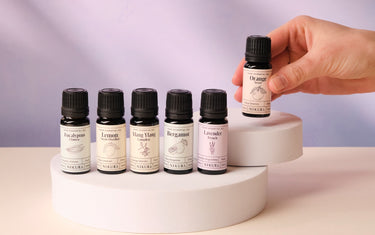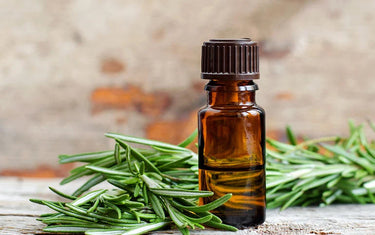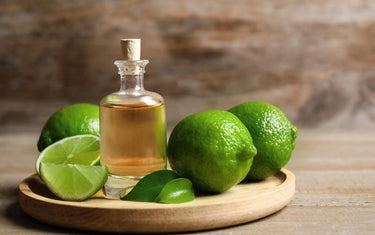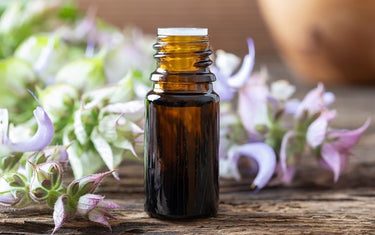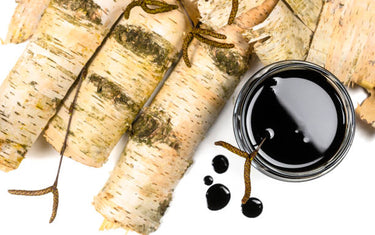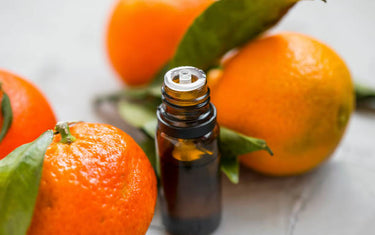7 min read / 28 March 2024 / yasmin sharp
8 Benefits and Uses of May Chang Oil
Discover the multifaceted benefits and uses of May Chang oil, a treasure in aromatherapy and traditional Chinese medicine.
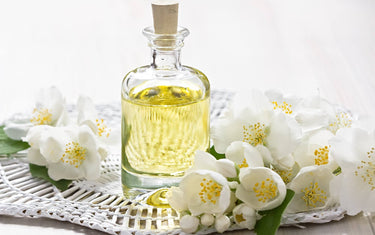
May chang oil is something of a newcomer to aromatherapy, first making an appearance in distilled form in the middle of the 20th century.
However, may chang has been a key part of Chinese medicine for hundreds of years, with practitioners using it to treat a whole manner of conditions.
Whilst people have traditionally enjoyed the benefits of may chang oil to improve digestive issues and provide pain relief, aromatherapy applications now provide the opportunity to experience its cleansing and calming qualities.
We take a closer look at some of the claims made about may chang essential oil to give you a rounded view about its wellness potential and how it could be included in your everyday life.
What is may chang oil?May chang essential oil – also known as litsea cubeba – is a cheering oil native to Southern Asia that is extracted via steam distillation from the root and stem of the plant. The oil is sometimes referred to as ‘mountain pepper’ due to its small, peppercorn-shaped berries and is often compared to lemongrass oil due to its citrusy scent, although it has a stronger, lemon-like smell that is much sweeter in comparison. Once extracted the oil is pale yellow in colour and it is often used by brands in cosmetic products, especially those intended for use on the skin. |
How does may chang oil work?
The chemical composition of may chang oil features compounds like linalool, nerol, citral and limonene, all of which have been found to provide various health benefits in various studies.
The natural properties of the oil can help the body and mind through different methods of application, such as aromatherapeutic treatments which help some people to relax and find a sense of calm.
Mixing may chang with a carrier oil and massaging into the skin can improve some skin conditions and also ease muscle aches and pains.
The oil can also be mixed with a carrier oil and added to a warm bath to create a water-based aromatherapy treatment, or included in candle and soap recipes.

What are the benefits of may chang oil?
Scientific studies suggest that may chang oil benefits could enable it to:
1. Provide antimicrobial protection
The antimicrobial properties of may chang essential oil have been well documented over the years, further strengthening its medicinal potential.
For example, one study published in 2014 found that the extracted oil could have a ‘broad application prospect in the antimicrobial area', whilst a more recent study highlighted that the abundance of a compound called citral could explain the cause of this antifungal activity. [1] [2]
The results of a separate in vitro study also stated that may chang essential oil could offer excellent fungicidal and anti-mycotoxigenic effects. [3]
2. Contain anti-cancer activity
Although studies are in their early stages, researchers believe that the vapour of volatile oils from may chang seeds could be used to combat lung cancer.
Various forms of non-small cell lung carcinoma are responsible for the growth of lung cancer and it can often become resistant to current chemotherapy treatments.
The results of a 2016 study showed that the vapour of volatile may chang seeds could be applied to attach lung cancer cells, helping to induce apoptosis whilst blocking cancer cells from rapid growth. [4]
3. Soothe stress and promote sleep
Practitioners of Ayurvedic medicine believe that may chang has the ability to pacify excess negative energy and help to rebalance spirituality.
Researchers have put these claims to the test in recent years, with results indicating that may chang oil could have a positive impact on insomnia and anxiety levels.
For example, a 2012 animal study looking at the neuropharmacological activities of may chang oil found that it could not only increase the amount of time subjects were able to sleep for, but anxiety levels could also be reduced during a stressful task. [5]
4. Support good skin health
As we mentioned earlier in the article, may chang essential oil has been found to contain strong antibacterial and antifungal properties.
One of the most common uses of may chang oil is as an all-natural skin cleanser, providing relief for oily skin and acne, thanks to its gentle nature and significant pore-clearing abilities.
Some also claim that using a diluted mixture of may chang oil can help to tackle common skin conditions such as eczema, psoriasis, and cellulitis.
In fact, one study suggested that the oil could prove to be effective at combating Cutibacterium acnes, a commensal skin bacterial species. [6]
5. Work as a natural deodorant
Perhaps one of the more surprising benefits of may chang oil is that it can be used as an ingredient in homemade natural deodorants.
Those who do use it for this purpose say it has the ability to reduce excess perspiration, reducing the negative effects it can have on skin.
The oil has a distinctive lemony scent that can be used to mask unwanted bodily odours to leave skin smelling cleaner and fresher.
You can try this at home by simply mixing a few drops of may chang essential oil with a carrier oil of choice, before applying to your underarms.

6. Ease digestive issues
In Chinese and Ayurvedic communities, may chang seeds are eaten to improve digestion, which suggests that the properties of the oil may be able to treat stomach-related issues.
Medium-chain fatty acids like lauric and capric acid account for around 66% of the oil’s content, which could strengthen these claims. [7]
Whilst lauric acid can provide good bacteria to help maintain a healthy microbiome in the gut, caprylic acid can be effective at treating inflammatory bowel conditions such as Crohn's disease. [8]
As we never recommend the internal consumption of essential oils because it could cause serious health complications, try diluting a few drops of may chang oil with a carrier oil and applying it externally to the abdomen.
7. Keep insects at bay
The bioactivity of may chang oil could make it an effective, natural insecticide that can be used against a variety of insects.
Researchers separated five constituents (31.58, 6.32, 1.26, 0.25, 0.05 nL/cm2) from may chang essential oil for the first time in 2014, finding that they contained strong fumigant and contact toxicities. [9]
May chang oil was tested against cigarette beetles and booklice, with the results suggesting that the oil and the compounds could have potential for use in repellents for stored products.
8. Boost heart health
May chang oil benefits may also include an ability to boost cardiovascular health by increasing blood flow to the heart.
An animal study investigated may chang oil’s cardiovascular-boosting effects and found that the oil was able to improve the ECG profile of subjects with cardiac arrhythmia – another benefit that is attributed to the presence of citral.

How do you use may chang oil?
May chang oil uses and applications have evolved through the years, with the oil now commonly used as an:
Aromatherapy agent
The bright, refreshing scent of may chang oil benefits the mind and body combined by creating a soothing atmosphere more conducive to relaxation.
Many people use its powerful natural properties to control stress and anxiety and to improve sleep patterns.
You can do this by adding a few drops to a diffuser or oil burner to help keep your emotions balanced in moments of distress.
Skincare balm
If you suffer from acne or skin conditions like eczema, you could try using may chang oil as a complementary treatment.
The antimicrobial properties of the oil can help to cleanse the skin, clearing up blemishes and marks with consistent application.
Simply mix a few drops with a non-comedogenic carrier oil (sunflower or grapeseed oil, for example) and apply it daily.
What is the history of may chang oil?
May chang has been active in Chinese and Ayurvedic cultures for centuries, finding use in a variety of applications.
It has traditionally been applied to treat stomach pain, headaches, lower back pain and muscular aches, with the fruits of the oil helping people with asthma and those with high blood pressure.
Compared to some oils, may chang is relatively young in age, as it was only first steam distilled in the 1950s, but its natural health properties and uplifting scent have seen it quickly gain a strong reputation in the modern age.

May chang oil FAQs
What are the risks of using may chang oil?
In general terms, may chang oil is considered safe to use, provided the correct dilution ratios are followed.
First-time users should complete a patch test to ensure their skin is compatible with the oil and should also avoid consumption, as it could cause serious health complications.
What does may chang oil smell like?
May chang oil has a positive lemony smell that is sometimes confused with lemongrass.
When it comes to blending with other essential oils, it mixes particularly well with the likes of black pepper, clary sage, basil, cedarwood, rosemary, thyme and orange.
Is may chang oil good for aching muscles?
The benefits of may chang oil has seen it traditionally used to soothe and ease muscular aches and lower back pain, making it an ideal massage balm.
To see if its natural properties can help you, mix 2-3 drops with a non-comedogenic carrier oil and apply to affected areas.
[1] Wen-Ru Li et al. (2014) Antibacterial Activity and Kinetics of Litsea cubeba Oil on Escherichia coli https://www.ncbi.nlm.nih.gov/pmc/articles/PMC4220960/
[2] Xue Wang et al. (2022) Antimicrobial activity of essential oils extracted from Litsea cubeba https://www.maxapress.com/article/doi/10.48130/FR-2022-0002
[3] Giseli Cristina Pante et al. (2021) Litsea cubeba essential oil: chemical profile, antioxidant activity, cytotoxicity, effect against Fusarium verticillioides and fumonisins production https://pubmed.ncbi.nlm.nih.gov/33645426/
[4] Soma Seal et al. (2012) Vapor of volatile oils from Litsea cubeba seed induces apoptosis and causes cell cycle arrest in lung cancer cells https://pubmed.ncbi.nlm.nih.gov/23091605/
[5] Chi-Jung Chen et al. (2012) Neuropharmacological activities of fruit essential oil from Litsea cubeba Persoon https://jwoodscience.springeropen.com/articles/10.1007/s10086-012-1277-3
[6] Jing Chen et al. (2022) Antibacterial Activity of the Essential Oil From Litsea cubeba Against Cutibacterium acnes and the Investigations of Its Potential Mechanism by Gas Chromatography-Mass Spectrometry Metabolomics https://www.ncbi.nlm.nih.gov/pmc/articles/PMC8924494/
[7] Carine Sebaaly et al. (2018) Potential Applications of Cyclodextrin Inclusion Complexes, Liposomes, and Drug-in-Cyclodextrin-in-Liposome in Food Industry and Packaging https://www.sciencedirect.com/topics/agricultural-and-biological-sciences/litsea-cubeba
[8] Aihiro Hoshimoto et al. (2002) Caprylic acid and medium-chain triglycerides inhibit IL-8 gene transcription in Caco-2 cells: comparison with the potent histone deacetylase inhibitor trichostatin A https://www.ncbi.nlm.nih.gov/pmc/articles/PMC1573354/
[9] Kai Yang et al. (2014) Bioactivity of essential oil of Litsea cubeba from China and its main compounds against two stored product insects https://www.sciencedirect.com/science/article/pii/S1226861514000466


